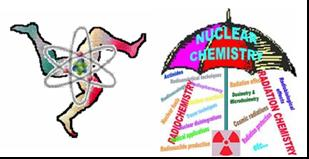Speaker
Dr
Maria Bubenikova
(Nuclear Research Institute Rez plc.)
Description
High liquid level waste (HLLW) issued from reprocessing of spent nuclear fuel contains dangerous nuclides, especially minor actinides (241,243Am, 245Cm, 237Np) responsible for long-term radiotoxicity of the waste. In the last decades, several HLLW partitioning processes for actinides separations based on the use of different extractants such as octyl(phenyl)-N,N-di-iso-butyl-carbamoylmethylphosphine oxide (CMPO) – TRUEX process, trialkylphosphine oxide – TRPO process, diisodecylphosphoric acid – DIDPA process, substituted malonamides – DIAMEX process, and N,N,N′,N′-tetraoctyl diglycolamide – TODGA process have been developed.
Over the last several years, the new families of extractants based on covalent bonding of hydrophobic cobalt bis(dicarbolides) [(1,2-C2B9H11)2-3-Co)]- anion (COSAN) to different metal chelating ligands (e.g. derivates of CMPO -, TODGA -, phenantroline -, organophosphorous - groups) were tested for separation of trivalent actinides from acidic waste solutions. Particularly two compounds from these series deserved further attention: (i) N,N-di-n-octyl-TODGA-COSAN containing two COSANs covalently bound to nitrogen atoms of diglycolic acid diamide platform via diethyleneglycol connectors (along with n-octyl as the second substituents on the amide nitrogen) and (ii) extractant N-terc.-octyl-CMPO-COSAN based on bounding of COSAN to CMPO group (with terc.-octyl on the amidic nitrogen atom and diphenyl substituents on phosphine end), also with use of the long chain diethyleneglycol connector. These extractants have proven very efficient, and have been thus evaluated in more details for the separation of actinides and lanthanides in the nuclear treatment. As we demonstrate, these derivatives enabled good separation of trivalent actinides and lanthanides from bulk of fission products present in the model PUREX feed. Undesirable co-extraction of some fission products, such as Mo, Zr, Pd could be suppressed by addition of oxalic acid and (hydroxyethyl)diaminetriacetic acid (HEDTA) into the feed and scrubbing solutions. Trivalent actinides and lanthanides can be effectively stripped from loaded organic phase by salts of citric acid and diethylenetriamine pentaacetic acid (DTPA). However, no selective separation of actinides from lanthanides either during extraction or during stripping with complexants has been obtained using these extractants. Therefore, several different DTPA-sodium nitrate solutions with or without buffers have been tested as an option for the selective actinides stripping. The results will be presented.
Primary author
Dr
Maria Bubenikova
(Nuclear Research Institute Rez plc.)
Co-authors
Dr
Bohumir Gruner
(Institute of Inorganic Chemistry, Academy of Sciences of the Czech Republic, v.v.i., Rez)
Dr
Jiri Rais
(Nuclear Research Institute Rez plc.)
Dr
Pavel Selucky
(Nuclear Research Institute Rez plc.)
Dr
Petr Svec
(Institute of Inorganic Chemistry, Academy of Sciences of the Czech Republic, v.v.i., Rez)




